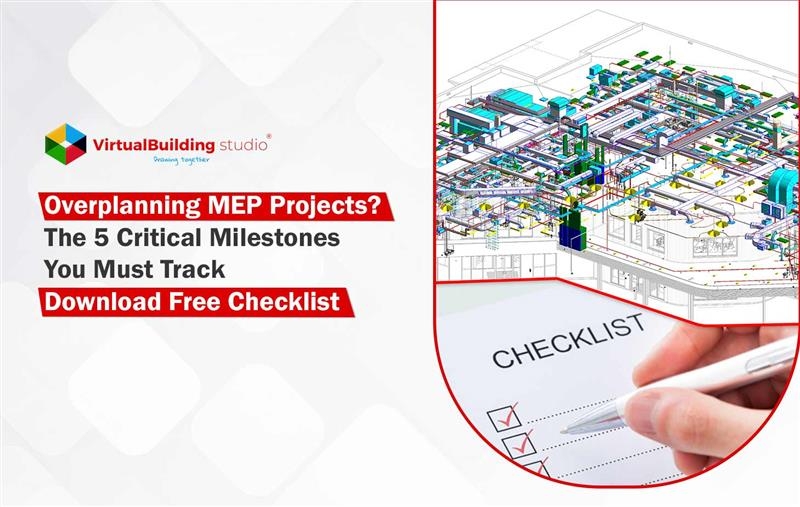
Why MEP Teams Can’t Afford to Overplan
In small MEP teams, every hour and dollar counts. Therefore, excessive planning often causes delays, not clarity. Instead of driving efficiency, it leads to decision fatigue, missed deadlines, and stalled execution.
Small teams often
- Juggle multiple roles
- Face scope creep
- Lack dedicated planners
According to Autodesk’s Digital Builder, “62% of general contractors attribute falling construction productivity to poor coordination and communication among project stakeholders.
Rather than over-documenting every step, focus on tracking the 5 critical milestones that truly impact delivery. They’ll help your MEP team stay on schedule, without drowning in complexity. This blog walks you through each.
Why Milestone-Based Planning Works
Milestone-based planning is a smarter, leaner way for small MEP teams to manage complex projects without getting buried in task overload. Instead of tracking every minor activity, it focuses on key checkpoints that indicate real progress, such as approvals, installations, and handoffs.
- It simplifies project tracking, so teams can see where they stand without needing daily micromanagement.
- It improves focus and accountability, aligning everyone around common, high-impact goals.
- It enhances adaptability, allowing teams to adjust quickly when real-world conditions such as delays, design changes, site access, etc., inevitably shift.
Think of it like using GPS checkpoints instead of obsessing over every turn during a traffic jam. When the road changes, your final destination stays the same, but how you get there adapts.
For small MEP teams with lean staff and tight timelines, milestone-based planning brings clarity without the clutter, and that’s the key to staying on track.
The 5 Critical Milestones – You Must Track
Not every task deserves your time, but these five milestones absolutely do. They act as project pressure points where things either move forward smoothly or spiral into costly delays. Track these, and you’ll stay in control, even with a lean team and shifting site conditions.
Milestone #1: Design Approval & Coordination Completion
This is where delays often begin. Small MEP teams frequently face constant design revisions, unresolved clashes between trades, and time-consuming efforts to perfect drawings. These challenges not only stall procurement but also increase the risk of rework and disrupt the construction schedule.
Milestone Actions:- Set a firm deadline for final design approval, including inputs from all consultants.
- Use BIM coordination tools like Navisworks and ensure all Level 2 clashes are resolved before issuing for construction.
- Prioritize constructability. Freeze design at a coordinated, buildable state to prevent delays in procurement and fabrication.
Pro Tip: Focus clash detection efforts on congested zones, like shafts and ceiling voids; these are high-risk areas for coordination failures.
Milestone #2: Material Procurement & Lead Time Management
Procurement issues can derail even the best-coordinated MEP plans. Last-minute shortages, long lead times, and expedited orders often lead to delays and budget overruns.
Milestone Actions:- Identify long-lead items such as AHUs, switchgear, VAVs, etc., early in the design phase.
- Issue POs promptly and track key dates like approval, fabrication, and delivery.
- Maintain buffer stock for essential or at-risk components to avoid downtime.
Pro Tip: Create a lead-time matrix aligned with installation dates to flag procurement risks before they impact the construction schedule.
Milestone #3: Rough-In Inspection & Compliance Sign-Off
Rough-in inspections are a critical checkpoint. If you fail here, your schedule takes a direct hit. Small teams often face delays due to failed inspections, unclear code requirements, or missing documentation. Idle time waiting for re-inspections not only wastes labor but also disrupts downstream activities, like drywall and ceiling closures.
Milestone Actions:- Schedule inspections well in advance, aligning with construction sequencing to avoid bottlenecks.
- Perform thorough pre-inspection checks, verifying system layout, clearances, labeling, and code compliance.
- Keep required documents ready, including approved shop drawings, pressure test results, and inspection checklists, for faster sign-off.
Pro Tip: Proactively coordinate with local inspectors during the early stages to clarify jurisdictional requirements. This reduces the risk of surprises and repeat inspections during crisis time.
Milestone #4: System Testing & Commissioning
Testing and commissioning delays can risk the final handover and client satisfaction. Late discovery of system defects, like poor HVAC balancing or electrical faults, often results in costly last-minute fixes. Small MEP teams also struggle with organizing and submitting complete documentation during turnover.
Milestone Actions:- Establish a clear testing and commissioning plan early, including system benchmarks, load testing, and safety protocols.
- Use calibrated tools and digital testers, like airflow meters, IR thermometers, circuit analyzers, etc., to speed up validation.
- Log test results in real time, ensuring transparency and reducing time spent compiling handover documentation.
Pro Tip: Involve commissioning agents early during installation phases to identify potential issues before final testing, which avoids last-minute surprises.
Milestone #5: Final Handover & Client Acceptance
The final handover is often underestimated. However, it directly impacts client satisfaction and timely payments. MEP teams frequently face delays due to unresolved punch list items, missing documentation, or inadequate system training. These oversights can stall approvals and stretch out project closeout.
Milestone Actions:- Conduct a pre-handover walkthrough with internal teams to identify and resolve minor issues before the client walkthrough.
- Prepare comprehensive O&M manuals, system warranties, and user guides tailored to the client’s needs.
- Use digital tools like Procore, PlanGrid, etc., for punch list tracking and e-signatures to streamline the acceptance process.
Pro Tip: Schedule a formal training session for end-users as part of the handover; it builds client trust and reduces post-handover support calls.
Conclusion: Simplicity Wins
Overplanning can overwhelm lean MEP teams and drain productivity. The key is to focus on the few milestones that truly drive progress, not every minor task. As the Pareto Principle reminds us, 80% of results come from 20% of the effort.
By tracking just the above five critical milestones, you’ll reduce delays, improve coordination, and keep projects moving, without unnecessary complexity. Start simple, execute smart, and scale your processes as you grow.
Need extra hands without the overhead or hiring hassle?
Try our Dedicated MEP Resource for flexible, on-demand support, exactly when you need it.




